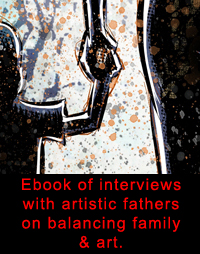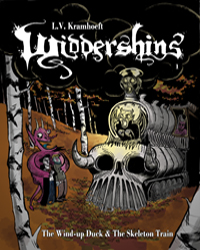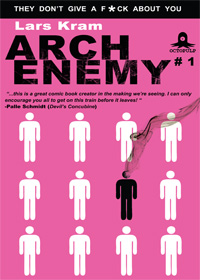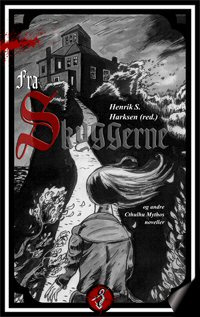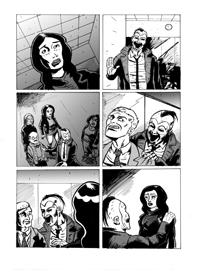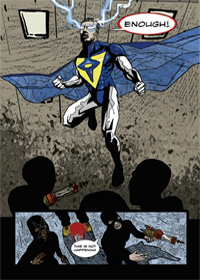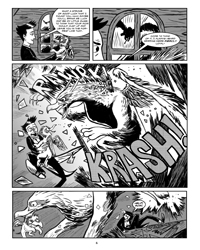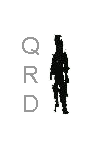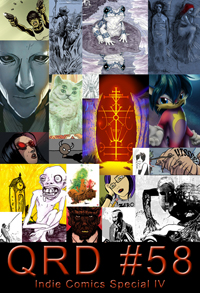
February 2013
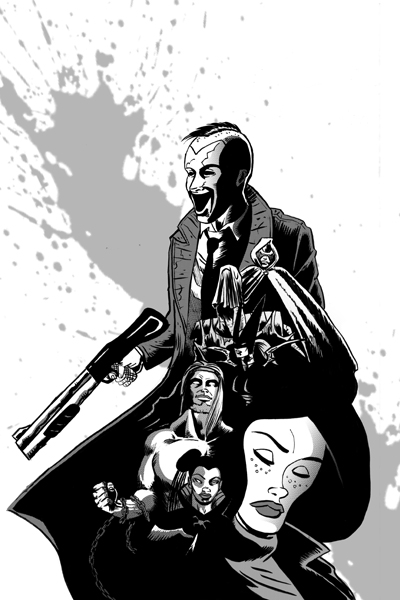
City: Viborg, Denmark
Comics: Arch Enemy, Made Flesh, The Grinning Man
Websites: Blog/online portfolio: raresightings.blogspot.dk, Ongoing weekly updated web-comic: madeflesh.blogspot.dk
QRD – How old were you when you first got into comics & did you always stick with them or did you come back to them?
Lars – I’m not sure when I started getting into comics, I seem to remember them always being around in some form or another. When I was very little it was mostly European comics like Tintin, then when I was around 7 or so I became infatuated with superheroes. I’ve been fairly loyal to comics as a whole, though my preferences have varied a lot over the years.
QRD – What was the first comic book you ever bought?
Lars – I have a very vivid memory of talking my parents into buying an issue of Superman for me when I was very young – does that count? I’d love to find that issue again. It blew me away completely. The issue focused on Gangbuster fighting some kind of cyborg in yellow armor, with Superman playing a smaller role, kind of just swooping in at the end & saving the day. The whole issue, as far as I remember, was this really long, really violent, & visceral dragged-out balls-to-the-wall fight between Gangbuster & this obviously superior cyborg character. I remember it as being masterfully told, like a real modern David versus Goliath. Then later I got into Spider-Man & X-Men, which were pretty much the only superhero comics you could find in Denmark around that time.
QRD – How old were you when you put out your first comic?
Lars – Again, it’s hard to say exactly when because I would make comic books even as a kid & sell to my friends & family. I have this really old comic book that I made when I was maybe five or six, drawn on this special recycled paper from Greenpeace that my mom would buy for me to draw on. This comic has some kind of story going on in it & there is lettering & word balloons; but I only knew how to draw letters & not how to put words together when I made it, so looking at it now is like picking up some strange alien artifact or something where you’ll never know what it’s really about! It does however have guns, ghosts, & jetpacks in it, so I was obviously already tuned into the same themes that I’m working with today. I guess I was in my mid to late teens when I produced my first “real” black/white photocopied indie comics that I sold in my local comic shop (this being Denmark, local means an hour & a half away by bus, but you get the idea).
QRD – Why comics instead of just writing or drawing?
Lars – I actually write short stories & scripts as well. I have a serialized novella starting in the e-zine Surreal Grotesque in either March or April, I forget which one. I’ve also had short stories published in my home country. I do think however that comics are an immensely strong storytelling medium. I love how you can play on both levels – what you can express with images & what you can say with words. Together it just has the potential to be very powerful. Like, Dan Clowes is a good example. Sometimes he has just one drawing, one image that will hit on something that’s so much more intangible than words, something that can almost make you break down & cry. & then at other times, it’s his dialogue or descriptive text that really hits the nail on the head. To me comics is the ultimate medium, much more potent than film or TV because it’s so much more intimate & personal & there are so many more different ways to tell the story. Split screens are only scratching the surface of what comics can do, you know! You can experiment so much more & break things up in so many more different & dynamic ways. & probably/maybe I’d say (going out on a limb here) comics are better at conveying physical action than the purely written word. Just like animation can be really good at playing with movement & weight, I can open a superhero book & really be blown away by a splash page of Aquaman knocking some big monster out.
QRD – Do you see mini-comics & indie comics as paths to mainstream comics or as their own unique media?
Lars – Both I guess. There’s obviously things you can do in indie comics that you can’t do in mainstream comics, but if you want to make money you have to play with the big boys. Not that there is anything wrong with that, it’s just the way it is. I understand that more people want to read Superman than a psychological horror story set in Denmark. Ideally, I’d do both, like Brian Wood or Grant Morrison.
QRD – How many copies of your comic do you print in your first run?
Lars – I’ve switched completely to digital, using Issuu or Graphicly for both the four issues of Arch Enemy I made & the weekly chapters of Made Flesh (the horror comic that I’m doing with Tom Kristensen), unless there is a publisher involved who’ll handle that part of it, like with my work for Gray Haven. When we finish Made Flesh some time this spring, we might try to self-publish it in a collected volume if we haven’t found a publisher for it & then that’ll be something we’ll have to figure out.
QRD – Do you think stories should be serialized or delivered as complete works?
Lars – Both, whichever work for the kind of story you’re telling obviously. I love to build up a relationship with the characters over a long time, I think that’s a big part of what makes superheroes so great. Other times it’s really nice to pick up a self-contained story that can give you a quick pulp fix while you’re on the john or eating a cookie.
QRD – What do you do better with your comics now than when you first started?
Lars – Everything I hope! Storytelling, story structure, composition, figure drawing, you name it.
QRD – Do you do thumbnails?
Lars – And how! I was trained in graphic design & also animation & therefore used to doing lots & lots of thumbnails. I didn’t do it before getting into those educations, but it’s a good way to test out a composition & getting a feel for the design aspect of it before spending many hours on it. I find the best comic artists are the ones that understand design as well as drawing & storytelling. When I write a script I usually do thumbnail breakdowns of the pages as well to be sure I don’t cram too much into one page.
QRD – At what size do you draw?
Lars – I prefer to do my thumbnails in Photoshop where it’s easy to fix things, cut & paste & scale stuff up or down. Then I print out the thumbnails in A3 & trace them onto Bristol board with either blue col-erase or a good hard pencil (2B), depending on my mood that day. Sometimes I put them on my light table & sometimes I’ll just sit with it on my lap on a piece of cardboard.
QRD – What kind of pens do you use?
Lars – After doing the pencils I usually like to work with a Pentel Color Brush that has a very nice smooth line, almost like a brush but much easier to control, & a couple of different artists pens like Faber-Castell’s Pitt pens or something similar.
QRD – What does your workstation look like?
Lars – Having a good, functional & also cozy workstation is so important since I spend most of my life there. I have a corner with two tables set at an angle. It’s close to a window so I can get natural light & fresh air easily. On the one table I have a computer & a tablet, & on the other I put my light table. On the walls I have massive boards to pin up character sheets, notes, inspirational images, reference, & so on. I keep a stack of comics & how-to books handy as well & I like to have plants, at least one, to have something alive nearby. That said, sometimes I’ll only be writing & (not drawing) for longer periods of time & then it’s sometimes nice to get out & go to a cafe or just sit in bed & write. Especially if you’re hung over, ha-ha.
QRD – At what point in the artistic process do you work digitally?
Lars – I like to work analogue for as long as possible. I even fill in massive black areas by hand, with a brush or a marker even though it takes longer than just clicking the paint bucket in Photoshop, ha-ha. There’s something about the analogue process that I like – creating a real piece of finished artwork, not just a digital file. I’m old school in that sense I guess. I’ll usually go digital once (or if) I color it or letter it, or just have to tweak some small stuff. With writing It’s just whatever’s handy – nothing beats a moleskin notebook, but a nice little program like Evernote is really cool though because it lets you access all your notes anywhere.
QRD – What do you think of digital comics & webcomics?
Lars – Anything that’ll get people to buy & read comics is fine by me. I still love my comic books though, I really like the feel & smell of paper, but I’ve been thinking of getting an iPad & checking it out. I must say the art & the colors look amazing on a tablet. I think both things can co-exist; it doesn’t have to be either one or the other. Tom has an iPad, but he still buys printed comics as well. Like Stephen King said, digital books are as much a threat to printed books as elevators are to stairs.
QRD – Do you prefer working in color or black & white?
Lars – I don’t prefer one to the other as such – it really depends on the story & the technical limitations such as printing costs, etc. Both can be amazing each in their own way.
QRD – How do you find collaborators?
Lars – Going out to parties & comic cons, getting shit-faced & waking up with strangers mostly. Also just trying to suppress my natural misanthropy & actually going up to people & talking to them, emailing them, or whatever. Sometimes they turn out to be really nice. Finding a good collaborator is like finding a girlfriend. You have to go through a lot before you find one worth keeping & you gotta take some chances. You can’t be too sensitive, you can’t hide in your room & be afraid of getting hurt, wasting your time, or whatever. Sometimes you do your best & things don’t work out. Other times it’s just like it was meant to be.
QRD – How tight do you think a script should be as far as telling the artist what to draw?
Lars – Well, I get to try & play both roles (writer & artist), so I might be able to offer some insight into this. As a writer I probably tend to become a little bit of a control freak because I think very visually & I’ll often have very specific images in my head of what I want things to look like. I’m writing two pitches for the Frankenstein anthology Unfashioned Creatures at the moment, that the incredibly talented Josephine Grant will be drawing & I’m constantly sending her reference pictures & even doing sketches of what I want characters to look like – I really must be horrible to work with, ha-ha! Yet at the same time, I know from working with writer Thomas Mets how nice it is as an artist to get the creative freedom to design characters for instance. You know, Danish director Lars von Trier once said that you should work with the most talented people, but let them do what they want instead of telling them what you want them to do (or something like that), that you’d get their best work that way. But it also depends on the project – if it’s something you’re developing together or if it’s more a matter of the artists “doing a job.” I’m very conscious of that. If I’m doing a job for someone, just providing the service of illustrating or visualizing something, it’s not my place to come with ideas or changes all the time. It’s always good to make those kinds of distinctions clear to yourself to get the most out of it & not get frustrated. I really do love working with other creative people though & as a writer I also really appreciate the artists’ input & ideas. Basically, a good idea is a good idea & if it improves the story & serves the overall vision it really doesn’t matter if it’s the writer or the artists that comes up with it, does it? The more fluid the process is, the better. Made Flesh with Tom Kristensen is the perfect collaboration for me. Since there is no money involved (yet), it’s all about us having a good time & creating a book that we like. We work like one organism almost – both of us doing thumbnails for instance – & sometimes I’m not even giving Tom a script, just a big chunk of prose that he interprets. Notice how I didn’t really answer the question at all?
QRD – What comic book person would you be most flattered to be compared to?
Lars – Probably Grant Morrison. He’s an amazing writer & a good-looking guy. I tried turning myself into him once as a sort of mental exercise & people would suddenly say, “Oh it’s you, I thought you were someone else!” He’s got a great fashion sense as well.
QRD – What do your friends & family think of your comics?
Lars – I’m not too sure actually. My family tends to think they’re a bit too dark & violent in general; but are otherwise very supportive, if at times, a tad worried about me, ha-ha.
QRD – What do you think of superheroes?
Lars – I friggin’ fucking love them.
QRD – Marvel or DC?
Lars – Used to be a Marvel fan (to such a degree that my first tattoo was a Spider-Man logo), but seeing as they’ve done their best to ruin absolutely everything that made their books good lately, I’m sticking solely to DC these days. I’m all about the new 52.
QRD – What comic characters other than your own would you like to work with?
Lars – That’s the question I’ve always waited for someone to ask! The answer is… Hawkman! & also, some of the other big guns, like The Flash, Bats, or Superman. That would be a real landmark to reach, something I would be really proud of. Imagine getting to add to that canon.
QRD – Ideally would you self-publish?
Lars – That’s a hard question. For a long time it’s been the only option really. Of course, now I’m starting to get work for Gray Haven & I must say I enjoy that tremendously. Not having to worry about a lot of practical aspects like promotion & distribution & just doing what I do best. & the atmosphere around it, my interactions with Marc Lombardi the editor & Thomas Mets the writer, is just so informal that it really just feels like we’re a bunch of guys who enjoy making good comics – which is how it should be. I have been doing the whole self-publishing thing, photocopying & stapling every single fucking issue & it’s just so much time that could be spent actually being creative. It especially sucks when you go to a con & then five people buy your book. I mean, I’m glad I tried it, it’s almost a rite of passage you have to have gone through as a comic writer/artist & I have had great experiences & made some of my best friends because of that, but I don’t see myself doing it in the future. Maybe I would self-publish digitally, but I’d honestly rather keep working with nice people in publishing such as Gray Haven who can deal with promotion & distribution etc. More people get to see my work that way & I might even make a bit of money; so the way I see it, it’s a win/win.
I will say this however – on a broader note – these days when more & more entertainment companies are turning into conglomerates (Disney buying Marvel & Lucas, etc.) it is important to hold on to culture as something we, the people, create. Not just something that is being handed down to us from big media like Disney. It’s important to remember that culture is what happens when people get together to make music, sing, dance, or make art. Something that happens when we interact & when we play. Not just because we want to make money, but because it’s fun & because it’s human nature. We can’t allow ourselves to be reduced to a culture of spectators. That is definitely the beauty of self-publishing. Meeting passionate people who love what they do. In that regard I’d like to give a shout-out to my friend Daniel Gonzales who runs The Surreal Grotesque e-zine that is so full of talented artists & writers that it continues to blow my mind month by month & also Emily Smith Miller who runs The Carnage Conservatory.
QRD – What do you do to promote your books?
Lars – I plug them shamelessly on all social media I have access to. FB, twitter, G+, LinkedIn, etc. It’s kind of a necessary evil &, again, I’d really much rather have a publisher doing it so I don’t have to scream & shout about myself & probably make people sick of me all the time.
QRD – What other medium would you like to see some of your comics made into (television, film, games, action figures, etc.)?
Lars – Made Flesh would make a nice horror movie. But I think comics are good enough as they are – they aren’t just a vehicle to get into film or TV. But it’s obviously a way to make more money as a creator. I honestly cringe most of the time when I see comics made into film, but a lot of people seem to like it & so if someone paid me for the right to do it, hey, awesome! I don’t know if this offends some people, but this is business as well & I like money. It allows me to travel & buy nice clothes & drugs.
QRD – What do you see as the most viable mediums for comics distribution 10 years from now?
Lars – Gene-spliced pterodactyls with plasma-screens imbedded in their wings maybe. I don’t know. I don’t dare to try & foresee the future. I’ll just look like a complete fool five years from now, ha-ha.
QRD – What would you like to see more people doing with comics?
Lars – Good stories told well, I guess. Experimentation. More self-contained books. More genre books that push the boundaries, more innovative sci-fi, fantasy, horror, etc. That’s really the kind of stuff I like. Something that challenges, provokes, & amazes. In Denmark genre-works aren’t really comme il faut, we have a strong tradition for social realism, both in film & literature, & you also see know how everyone wants black & white graphic novels about some molested kid on a farm in Poland, which is fine I guess, I just always found that the fantastic genres were much more elegant & interesting in their way of dealing with basic human emotion & subject matter on a metaphorical level. I have been touched much more deeply by Superman than by Persepolis or l’ascension du haut mal, for instance. & I love to open a book & be blown away be some outlandish idea or concept, like a man pulling a planet out of orbit or a golem made of time. I’m not saying realistic comics can’t be amazing; I just really love the metaphorical potential of the fantastic genres. I love books that give me that larger-than-life “wow-feeling” & here’s the kicker – it doesn’t work unless it is also grounded in solid & believable characters, just like in realism.
QRD – Anything else?
Lars – Yeah, never be afraid, it’s just a ride, read some books & keep an eye out for mine & Thomas Met’s comic The Grinning Man coming from Gray Haven in April 2013!






